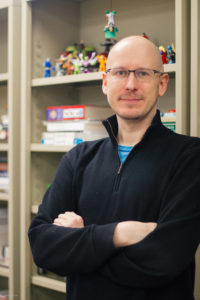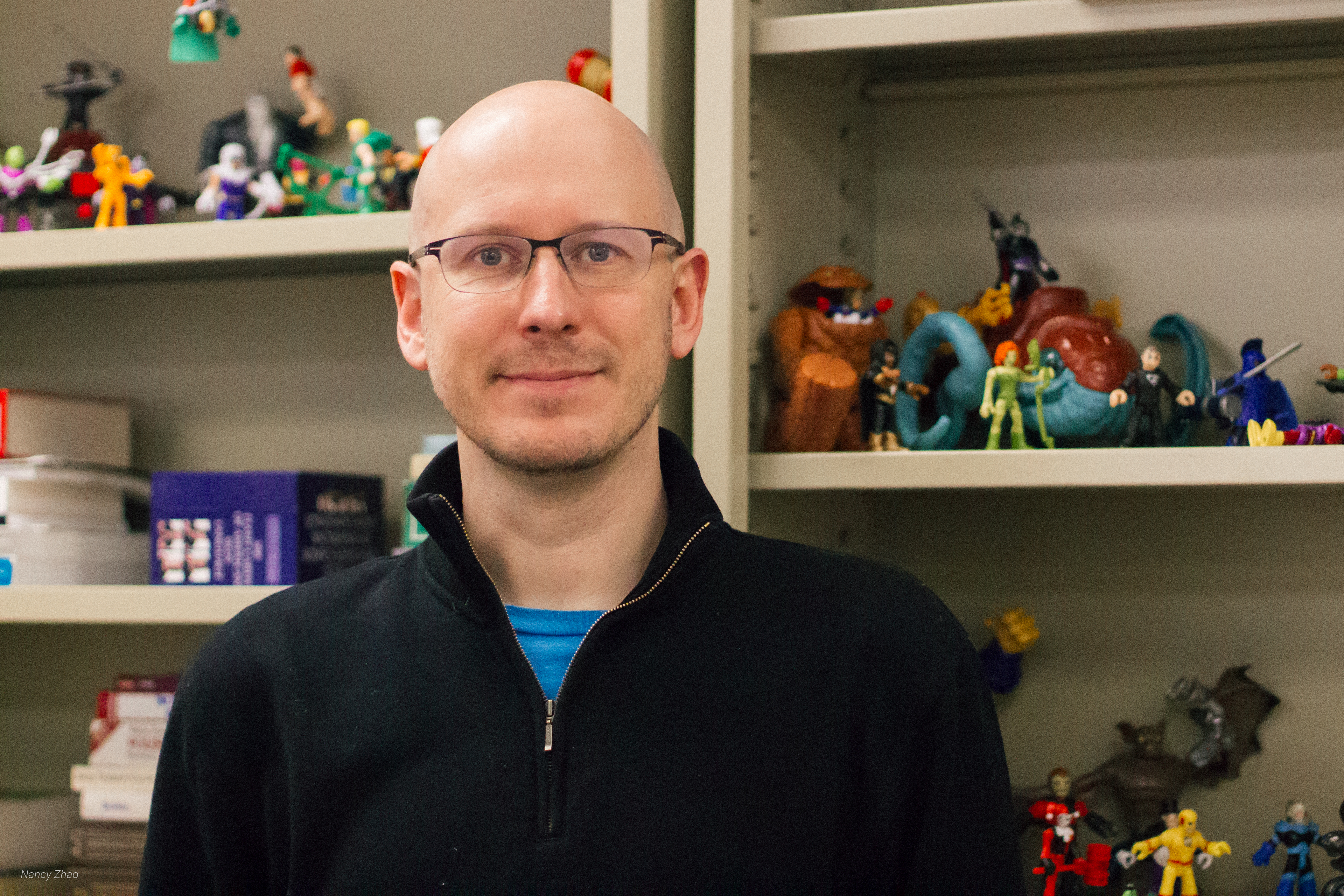Intersecting STEM and the humanities

For Professor Nathan Sanders, STEM and the arts are not mutually exclusive. Currently an assistant professor with the Department of Linguistics here at UofT, his areas of research and expertise are grounded in both the sciences and the humanities. Following is our discussion on how he has integrated these two seemingly antithetical academic areas in his work throughout his career, as well as his thoughts on common misconceptions that may be fueling the tension between the two.
Throughout grade school, Professor Sanders was passionate about the sciences, but also had a keen interest in languages, and studied multiple during school. He observed that he wasn’t approaching each language simply by rote memorization of verb charts, however:
One of the things that I was doing that I didn’t realize that I was doing, is I was approaching languages from a very scientific point of view. I was trying to figure out how they worked, what was their structure; I was looking at the patterns, not what you typically do.
“Then in university I took a linguistics course and discovered that I had been doing linguistics on my own… then I fell in love with the field. It was basically a marriage of my two interests: this mathematical, scientific approach to looking at the world, and language.” Originally intending on pursuing a degree in just math, Professor Sanders graduated MIT with a Bachelor of Science in math with a minor in linguistics, and then went on to earn his masters and PhD in linguistics.
Although the field of linguistics in itself has always had a strong science element to it, Professor Sanders’ work “goes even farther than some linguists” in terms of its incorporation of concepts generally confined to STEM fields.
“My main area of study is phonetics and phonology, so I look at sounds primarily, and the phonetics side of that is physics. It’s sound waves, frequency, resonance; and lately I’ve also been working on sign languages, and looking at the phonetics of sign languages. So the physics of the body: how does the torso move, how does arm movement affect the torso; so I’m looking at things like mass and acceleration and force and torque and rotational inertia.”
He does feel there are many misconceptions surrounding methodologies and characteristics that are taken to be defining traits of certain fields. Looking at STEM for example, those outside this area may “make assumptions about how rigorous it is. There’s a lot of art to how you decide which way to analyse something. You’ve got your data, and you’ve got to come up with some analysis of why the data is distributed the way it is, and it’s a little bit of an art trying figure that out, so there is some arbitrariness on the STEM side that I think is not perceived by the other side; and I also think that outside STEM, people think that STEM doesn’t see the bigger picture, the heart, the humanity in what they’re doing. I think they say “Oh, they’re just dealing with numbers, they’re not dealing with real people, or real emotions.” And they are—it just doesn’t show up as obviously. Linguistics in particular, I think, is an area where this is very clear. In sociolinguistics or documenting endangered languages, the people are a huge factor in what we’re doing; so these things are happening, often behind the scenes, often backgrounded rather than foregrounded in the sciences; so I think that’s something where STEM is perceived one way, but it’s not a totally accurate perception.
“Conversely, I think that STEM folk look at the humanities and think that it’s all fluffy, that it’s all opinion, that it’s all anecdotes, that it’s not rigorous—that two different people can look at the same thing and come up with completely different interpretations and that either one is equally valid or invalid, that it doesn’t matter. And again, this is something that’s about the surface part—it appears that way. But there is rigour behind what’s going on. People aren’t just making random things up; they’re basing it on the evidence that they see, and they may not be using mathematical formula to derive their results, but they’re using a rigorous process in their head—logical thought and argumentation. They’re making connections to things that could be missing in mathematical analysis.
“I was noticing something the other day, it’s like if you happened to look at a particular author and you get the sense that they use metaphors way more often than comparable authors do, if you’re in the humanities you might just say that. You might just say “Mary Smith uses metaphors more than her contemporaries do,” but over on the sciences side somebody might say, “let’s test that,” and they count up the number of metaphors, and it turns out that everyone uses about the same amount of metaphors. But there was still something right about what was said on the humanities side because they noticed it, so why did they notice it? And it could be because those metaphors that she used are more resonant, they’re more evocative, more colourful; there’s some unquantifiable quality that the humanities person is noticing that the sciences person who’s just looking at it numerically is missing. And so what we see is that both of these are working together to give us a picture of what’s going on.”
“The picture is that everybody’s using metaphor the same to the same amount, but this person is using something extra, this ineffable quality of an obvious metaphor or an effective metaphor, that you just can’t measure, you can’t put a number on it. And so both approaches are important. You need this just raw, gut, emotional human reaction to what you’re seeing, and you need numerical quantification to get the full picture of what’s happening. So I think when there’s tension between the sides, part of it is not seeing the value in what the other side is doing and not seeing that they are actually doing these things that you think they’re not.”
In terms of why tension exists between the two, Professor Sanders believes that a significant cause for divide is that “we are socialized to believe that these two ways of viewing the world are very different. I think we’re socialized to believe that growing up, you’re a math person or you’re a language person. If you happen to show a slight preference to one, that gets picked up on by your teachers, and they keep pushing you in that one direction, and you don’t get as much practise using the skills needed for the other side. So I think that’s one aspect, we’re just socialized to believe, so you grow up to be one of these people, and you socialize the next generation, and it’s just this endless cycle.
“So then the question is: why is there a tension, why don’t we just say, “Oh there’s STEM people and there’s not-STEM people and we’re all happy.” I think humans just have a general ‘us versus them’ mentality, that if you’re in your group, your group’s the best and so I think there’s just this natural tendency to do that, especially when it’s something so fundamental as how you think, the way you look at the world, that seems like such a basic component of your identity. And we put a lot of emotional content on this division. We talk about humanities and STEM people in both positive and negative ways that ties it to our emotional reaction to these things; so STEM is cold and detached but rational and logical. Humanities are foofy and opinionated and flighty and not grounded in patterns, but they’re also aware of the humanity, the human condition, they have a deeper connection to what’s going on with people. So I think the way we talk about these fields also drives this tension, and so we butt heads. I think it’s just a self-perpetuating cycle.
“This is one of the things that I like about linguistics because it straddles the boundary. It’s dealing with language, which is rooted in people, people’s interactions, but it’s a scientific mathematical approach to studying language and so it has to deal with both. It’s a really beautiful interdisciplinary field, because you have people at the really STEM-y end like me who are doing the physics of language, and then you have people at the more humanities end living and working with communities to document their language and culture, it’s this nice range from science to humanities and everything in between.”
While ideally Professor Sanders encourages taking as many varied courses as possible, he realizes the practical limitations on this, and instead chooses to emphasize to his students that “this is a really special time in your life as a student. There are very few times in your life when you’re going to be able to take random classes from world class experts on anything. Name a topic and there’s a class on it, and it’s going to be taught by someone who really knows the material and I try to get students to take full advantage of that. You have this opportunity, you can go take these classes, so go do it, because once you’re out in the real world working your job you’re not going to have that opportunity.”
This interview has been edited for length and clarity.
